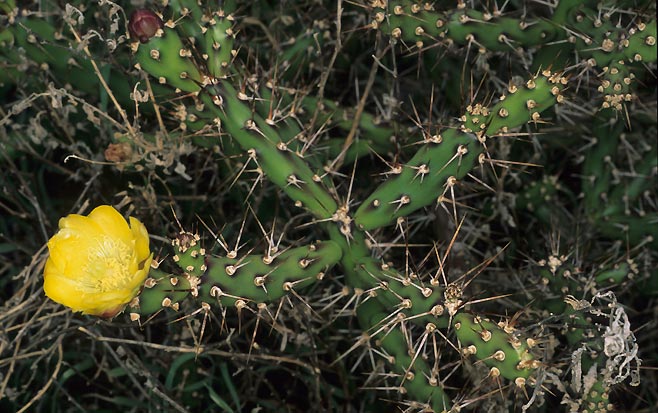|
Opuntia aurantiaca (Jointed cactus)
Life
> eukaryotes >
Archaeoplastida >
Chloroplastida
>
Charophyta > Streptophytina > Plantae (land plants)
> Tracheophyta (vascular plants) > Euphyllophyta > Lignophyta (woody plants)
> Spermatophyta (seed plants) > Angiospermae (flowering
plants) > Core Eudicots
> Order: Caryophyllales >
Familty: Cactaceae > Genus:
Opuntia
 |
|
Opuntia aurantiaca (Jointed cactus), near
Kirkwood in the Eastern Cape, South Africa. [photo H. Robertson, Iziko
©] |
Description
An inconspicuous plant that grows among the
surrounding vegetation and is usually less than half a meter high
although it can exceed this height by using adjacent scrub for
support. Cladodes (the segments of stem modified for water storage
and photosynthesis), are small and elongate and those that become
rooted and buried become woody. Woody cladodes and fruit
constitute 7% of the cladodes in a stand of Jointed cactus plants
and constitute 25% of the stand in terms of mass because these
cladodes are relatively large (Robertson 1985a).
Jointed cactus plants have a number of different growth forms
depending mainly on the amount of direct sunlight they receive.
Three main growth forms can be distinguished:
-
explosed forms tend to be low growing and
have small cladodes with long spines;
-
semi-shade forms have long spines, a high
proportion of large cladodes and often exceed half a meter in
height by using the surrounding bush for support; and
-
etiolated forms occur in the shade, also
often exceeding half a meter in height, are characterised by
elongate cladodes and in deep shade have short spines.
Distribution and habitat
A
declared
Category 1 invasive plant in South Africa.
Life cycle
- The cladodes break off the plant easily and take root, often
below the plant. This eventually results in the formation of
stands of Jointed cactus plants, sometimes covering more than 5
m2 in ground area.
- Other cladodes become attached to animals or are carried
away by water and in this way are distributed over large areas.
- The inedible fruits produced by Jointed cactus can also take
root easily. The seeds they contain are 99.95% sterile
(Archibald 1936) and so reproduction is almost entirely
vegetative.
Ecological interactions
Herbivores in southern Africa
The following insects have been introduced
to South Africa for biological control purposes and have become
established:
-
Cactoblasis cactorum (Lepidoptera:
Pyralidae:
Phycitinae). This moth was introduced in 1933 for the
biological control of
Opuntia ficus-indica (Prickly pear) but it has a
number of other cactus host plants, including Jointed cactus.
The orange and black striped larvae eat the parenchymous
tissue inside the cladodes and cause moderate damage to
Opuntia aurantiaca infestations (Klein 2011).
-
Dactylopius austrinus (Hemiptera:
Dactylopiidae). A cladode sucker that was released in
South Africa in 1935 for the biological control of
Opuntia aurantiaca, and which causes extensive damage to
this weed (Klein 2011). Dactylopius species are
collectively known as cochineal insects and are all
characterised by having vivid red body contents that from
Dactylopius coccus
is used for producing cochineal
dye. The females suck the juices from the cactus and are easily
noticed on the plant because of their untidy covering of waxy
filaments, looking rather like blobs of cotton wool.
-
Mimorista pulchellalis (Lepidoptera:
Crambidae:
Spilomelinae). This moth was released in South Africa in
1979 for the biological control of Opuntia aurantiaca.
Although it did initially become established, it is now
regarded as not having become established (Klein 2011). Two
other moth species: Nanaia sp. and Zophodia
tapiacola (= Tucumania tapiacola) (both in the
family
Pyralidae) were also released but failed to become
established.
Publications
- Archibald E.E.A. 1939 The development of the ovule and seed
of jointed cactus (Opuntia aurantiaca Lindley). South
African Journal of Science 36. 195-211.
-
Klein H. 2011. A
catalogue of the insects, mites and
pathogens that have been used or
rejected, or are under consideration,
for the biological control of invasive
alien plants in South Africa. African
Entomology 19(2): 515-549.
Moran V.C. and Cobby B.S.1979. On the life-history and
fecundity of the cochineal insect, Dactylopius austrinus
De Lotto (Homoptera: Dactylopiidae), a biological control agent
for the cactus Opuntia aurantiaca. Bulletin of
Entomological Research 69(4): 629-636. DOI:
10.1017/S0007485300020174
- Moran V.C., Zimmermann H.G. 1991. Biological control
of jointed cactus, Opuntia aurantiaca (Cactaceae), in
South Africa. Agriculture, Ecosystems & Environment 37(1-3):
5-27. doi:10.1016/0167-8809(91)90136-L
Text by Hamish Robertson
|
